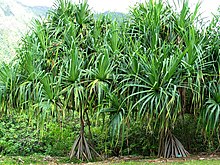Pandanaceae
| Pandanaceae Temporal range:
| |
|---|---|

| |
| Pandanus tectorius | |
| Scientific classification | |
| Kingdom: | Plantae |
| Clade: | Tracheophytes |
| Clade: | Angiosperms |
| Clade: | Monocots |
| Order: | Pandanales |
| Family: | Pandanaceae R.Br.[1] |
| Genera | |
Pandanaceae is a family of flowering plants native to the tropics and subtropics of the Old World, from West Africa through the Pacific. It contains 982 known species[2] in five genera,[3] of which the type genus, Pandanus, is the most important, with species like Pandanus amaryllifolius and karuka (Pandanus julianettii) being important sources of food. The family likely originated during the Late Cretaceous.[4]
Characteristics
Pandanaceae includes
The plants are dioecious. The inflorescences are terminally borne racemes, spikes or umbels, with subtended spathes, which may be brightly colored. The flowers are minute and lack perianths. Male flowers contain numerous stamens with free or fused filaments. Female flowers have a superior ovary, usually of many carpels in a ring, but may be reduced to a row of carpels or a single carpel. Fruits are berries or drupes,[5] usually multiple.[7]
Pandanaceae includes five genera: Benstonea, Freycinetia, Martellidendron, Pandanus, and Sararanga.[3] Benstonea (as subgenus "Acrostigma")[8] and Martellidendron[9] were formerly considered subgenera of Pandanus, but were recognized as distinct genera based on DNA sequencing.[9][8]
| Pandanaceae | |
Uses
Particular species of Pandanus are used to make mats (e.g. Central Africa) or in food products (e.g. leaves as flavoring, or fruit in Southeast Asia).
References
- hdl:10654/18083.
- .
- ^ a b taxonomy. "Taxonomy Browser". www.ncbi.nlm.nih.gov. Retrieved 29 October 2018.
- S2CID 21864828.
- ^ a b "Pandanaceae in Monocot Families (USDA) @ efloras.org". www.efloras.org. Retrieved 29 October 2018.
- ^ "Pandanaceae in Flora of China @ efloras.org". www.efloras.org. Retrieved 29 October 2018.
- ^ "Angiosperm families - Pandanaceae R. Br". delta-intkey.com. Retrieved 29 October 2018.
- ^ a b "Update on the systematics of Benstonea (Pandanaceae): When a visionary taxonomist foresees phylogenetic relationships" (PDF). (50 KB)
- ^ a b ingentaconnect: Recognition of Martellidendron, a new genus of Pandanaceae, and its biogeographic implications
